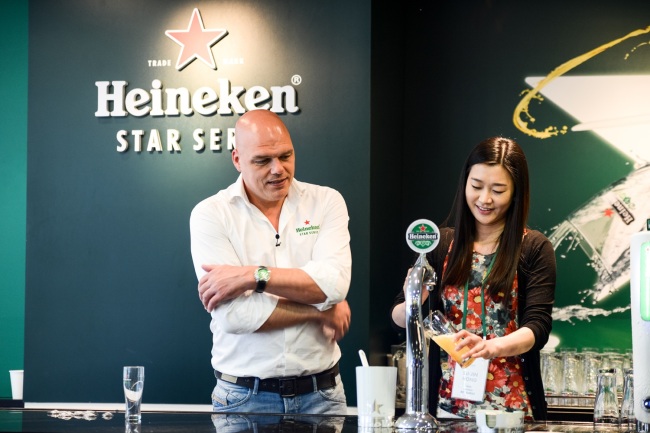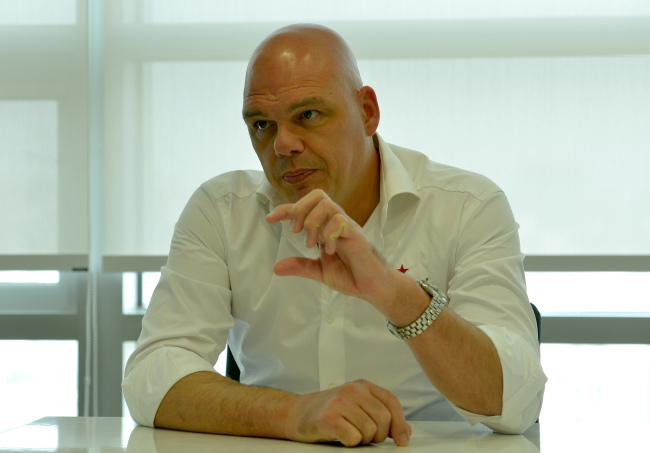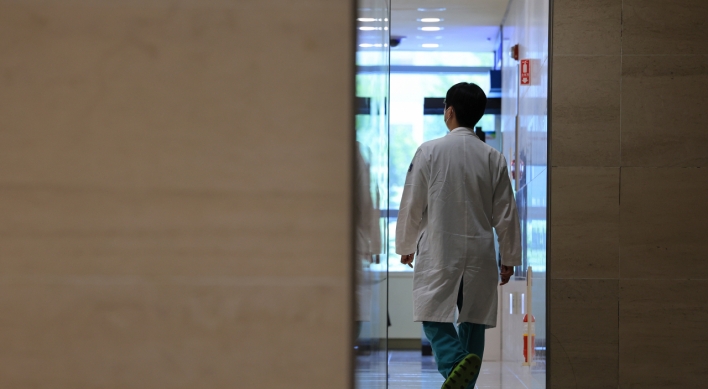[Weekender] What a difference a draught master can make
Beer poured just right is the perfect thirst quencher for hot summer’s day
By Korea HeraldPublished : May 16, 2014 - 21:01
When it comes to a glass of a cold one, Franck Evers finds the same problems everywhere around the world.
“Temperature, dirty glassware, too much or too little foam, and presentation. These are the four major issues with serving beer,” noted Evers, a Dutchman who holds the unusual title of Heineken Global Draught Master. Since assuming the post in 2006, he has traveled to some 60 countries, spreading the gospel of how to pour the perfect glass of draught beer.
“It is not marketing gimmickry,” insists Evers as he points to the five steps to serving draught beer ― called the “Star Serve” ― on the wall behind a counter set up in Heineken Korea’s office in southern Seoul. Following the steps makes beer fresher and easier to digest, Evers assures in his booming voice.
The first step is rinsing and cleaning the glasses. “Make sure there is no lipstick stain,” Evers says as he holds up a glass that he has just cleaned and rinsed to inspect it under the light. Surprisingly, dirty glassware is a common problem that affects the taste and look of beer, he notes.
The next step is the actual pouring, making sure to hold the glass at a 45 degree angle to the nozzle and opening the tap fast. As the glass fills, straighten it.
“Temperature, dirty glassware, too much or too little foam, and presentation. These are the four major issues with serving beer,” noted Evers, a Dutchman who holds the unusual title of Heineken Global Draught Master. Since assuming the post in 2006, he has traveled to some 60 countries, spreading the gospel of how to pour the perfect glass of draught beer.
“It is not marketing gimmickry,” insists Evers as he points to the five steps to serving draught beer ― called the “Star Serve” ― on the wall behind a counter set up in Heineken Korea’s office in southern Seoul. Following the steps makes beer fresher and easier to digest, Evers assures in his booming voice.
The first step is rinsing and cleaning the glasses. “Make sure there is no lipstick stain,” Evers says as he holds up a glass that he has just cleaned and rinsed to inspect it under the light. Surprisingly, dirty glassware is a common problem that affects the taste and look of beer, he notes.
The next step is the actual pouring, making sure to hold the glass at a 45 degree angle to the nozzle and opening the tap fast. As the glass fills, straighten it.

The skimming of the top of the foam with a spatula is a crucial part of the “Star Serve” which makes the foam dense by packing it. “The top of the foam holds oxygen and the bitter part of hops. At the same time, it creates surface tension.”
The two final steps are checking the glass of beer for the perfect foam and serving it with a smile.
The steps Evers passes on are a ritual for pouring a lager beer: Different types of beer should be served in different ways to enhance the drinking experience, according to Evers.
“Everything is done to protect the foam to keep the beer fresh,” says Evers.
“The C02 keeps the beer fresh, activates the taste buds and activates freshness in the mouth. The foam keeps oxygen from interfering with beer,” says Evers as he pushes a glass of beer fresh from the tap across the counter. With just one sip, the difference a perfect pour can make is clearly tasted: It is light and fresh without any bitterness.
“Beer is the most original thirst quencher we know,” says Evers, explaining that beer brewing goes back some 6,000 years. “It is cold, fresh, goes down easy. It doesn’t have too much alcohol and it doesn’t need to be sweet,” he says.
The right way to drink the perfectly poured glass? Never slurp up the foam at the top of the glass. Rather, put the foam against the upper lip, tilt the glass and wait to feel the beer. “Aim to drink it while the foam is there,” Evers advises, “taking 2-3 sips in a row.”
Will serving beer the right way help sell more beer? The answer is a resounding yes. “The only reason to order a second beer is the quality of the first one,” Evers claims.
The globe-trotting Draught Master, who visits about 25 countries a year, was in Nigeria the previous week as part of the “Star Serve” training program. Evers has developed a 90-page manual on pouring the perfect draught beer, a process he has developed over a 14-year period.

“It is all about spreading knowledge about how to treat beer best,” says Evers. “It takes 28 days to brew beer. It can be ruined in five seconds by a barkeeper,” he says.
It was Evers’ love of beer that steered him from being a psychiatric nurse to the world of bartending. “I lived above a bar. I had a neighbor who owned a bar and I helped him out when he was busy,” Evers says of how he got started working with beer. After two years, he bought the bar. “I worked 100 hours a week as a nurse, tennis teacher and bar owner,” Evers says.
A year later, he met Freddy Heineken, the third-generation Heineken of Heineken International. “He inspired me to think big, act little,” Evers recalls.
What Evers preaches is not new. “An 1882 book, a barkeeper’s manual, published in the U.S. talks about how to pour beer,” says Evers, adding that all the big brands already have their own procedures.
“The only thing Heineken did is make it special. Heineken gave me an opportunity to make it unique,” Evers says.
Although Evers works with beer, his own beer-drinking only happens after work. “Never during the day,” he says emphatically. Not a big drinker, he likes to sample different beers when traveling.
He notes that different cultures have different ways of drinking beer. The previous day at a restaurant, he saw a new tap, a kind he had never seen before.
“There are a lot of taps but it was new to see two spouts, one for the foam and one for the beer. The artificial foam is a mix of gas used to make a glass of beer look better,” he says. A picture-perfect glass of beer, but the taste would not be perfect.
He also noted the use of pitchers to serve beer. “The Dutch are aghast at this. But if we show it elsewhere, they would say, ‘What’s the problem?’” Evers says.
In fact, it’s a huge problem, according to Evers. “All the bad things are happening inside that pitcher. If pitcher is finished within 10 minutes, that would be acceptable,” Evers says, “bad things” referring to the oxidization of beer as the foam thins and the warming of the beer as it sits in a plastic pitcher.
Experts agree that beer needs to be treated in a certain way, according to Evers, and every beer has its own ritual and should also be served in different types of glasses, just as different types of stemware are needed for different wines. A lager is served in a head-keeper glass that is narrower at the bottom, while darker beer should be served in a round glass, Evers explains.
If you freeze the glass, it should be dry as any water on it will affect the foam. The best drinking temperature is 3 to 5 degrees Celsius. Serving it at 0 degrees Celsius will allow the beer to be enjoyed at the optimal temperature as the temperature of the beer in the glass will go up about 1 degrees Celsius per minute.
If you get a bottled beer, drink straight from the bottle ― do not pour, Evers advises. “A can is even fresher because there is no air at all,” he says.
Consider a lager an “appetizer,” Evers says, as the hop activates the taste buds and the CO2 aids with digestion. Finger foods go well with lager as do spicy foods, as alcohol is a very good cleanser. Belgian beers are best enjoyed with clams or meat. White beer, on the other hand, is like white wine.
By Kim Hoo-ran, Senior writer (khooran@heraldcorp.com)
-
Articles by Korea Herald








![[Kim Seong-kon] Democracy and the future of South Korea](http://res.heraldm.com/phpwas/restmb_idxmake.php?idx=644&simg=/content/image/2024/04/16/20240416050802_0.jpg&u=)










![[Today’s K-pop] Zico drops snippet of collaboration with Jennie](http://res.heraldm.com/phpwas/restmb_idxmake.php?idx=642&simg=/content/image/2024/04/18/20240418050702_0.jpg&u=)